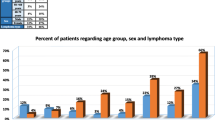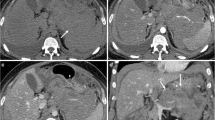Abstract
Purpose: The aim of this study was to evaluate the pattern of FDG uptake in pancreatic non-Hodgkin’s lymphoma (NHL) lesions. Methods: The study included 9 consecutive patients with newly diagnosed NHL with pancreatic involvement who underwent an F-18 fluorodeoxyglucose positron emission tomography/computed tomography (F-18 FDG PET/CT) scan. The location, size, maximal standardized uptake value (SUVmax), and FDG uptake patterns of the pancreatic lesions were reviewed. Results: Four different patterns of FDG uptake could be distinguished in the affected pancreas corresponding to different types of lymphoma lesions. These included focal FDG uptake by distinct solitary lesions (5 patients), multiple foci of FDG uptake corresponding to separate lymphoma lesions (1 patient), segmental FDG uptake caused by lymphoma infiltration limited to a pancreatic segment (1 patient), and diffuse FDG uptake related to diffuse lymphomatous infiltration of the entire pancreas (2 patients). All types of lesions showed increased metabolic activity with maximal standardized uptake values (SUVmax) ranging from 7.4 to 26.5. On CT images, the segmental and diffuse patterns of FDG uptake correlated to segmental and diffuse pancreatic enlargement accordingly. All lesions showed isodensity or slight hypodensity in relation to pancreatic tissue. The pancreatic head was the most frequent site of involvement (8/9). Mildly dilated pancreatic duct was noted only in 2 patients. Conclusions: The described patterns of FDG uptake and correlative CT findings may be helpful for a better characterization of NHL involving the pancreas and for differential diagnosis with other lesions, including pancreatic adenocarcinomas.









Similar content being viewed by others
References
Glazer HS, Lee JK, Balfe DM, et al. (1983) Non-Hodgkin lymphoma: computed tomographic demonstration of unusual extranodal involvement. Radiology 149:211–217
Low G, Panu A, Millo N, Leen E (2011) Multimodality imaging of neoplastic and nonneoplastic solid lesions of the pancreas. Radiographics 31:993–1015
Rosenberg SA, Diamond HD, Jaslowitz B, Craver LF (1961) Lymphosarcoma: a review of 1269 cases. Medicine (Baltimore) 61:31–84
Nakamura E, Shimizu M, Itoh T, Manabe T (2001) Secondary tumors of the pancreas: clinicopathological study of 103 autopsy cases of Japanese patients. Pathol Int 51:686–690
Adsay NV, Andea A, Basturk O, et al. (2004) Secondary tumors of the pancreas: an analysis of a surgical and autopsy database and review of the literature. Virchows Arch 444:527–535
Merkle EM, Bender GN, Brambs HJ (2000) Imaging findings in pancreatic lymphoma: differential aspects. AJR Am J Roentgenol 174:671–675
David M, Lepage C, Jouve JL, et al. (2009) Management and prognosis of pancreatic cancer over a 30-year period. Br J Cancer 101:215–218
Ghaneh P, Costello E, Neoptolemos JP (2007) Biology and management of pancreatic cancer. Gut 56:1134–1152
Webb TH, Lillemoe KD, Pitt HA, Jones RJ, Cameron JL (1989) Pancreatic lymphoma. Is surgery mandatory for diagnosis or treatment? Ann Surg 209:25–30
Moog F, Bangerter M, Diederichs CG, et al. (1998) Extranodal malignant lymphoma: detection with FDG PET versus CT. Radiology 206:475–481
Schaefer NG, Hany TF, Taverna C, et al. (2004) Non-Hodgkin lymphoma and Hodgkin disease: coregistered FDG PET and CT at staging and restaging—do we need contrast-enhanced CT? Radiology 232:823–829
Ilica AT, Kocacelebi K, Savas R, Ayan A (2011) Imaging of extranodal lymphoma with PET/CT. Clin Nucl Med 36:e127–e138
Even-Sapir E, Lievshitz G, Perry C, et al. (2007) Fluorine-18 fluorodeoxyglucose PET/CT patterns of extranodal involvement in patients with Non-Hodgkin lymphoma and Hodgkin’s disease. Radiol Clin North Am 45:697–709
Paes FM, Kalkanis DG, Sideras PA, Serafini AN (2010) FDG PET/CT of extranodal involvement in non-Hodgkin lymphoma and Hodgkin disease. Radiographics 30:269–291
Metser U, Goor O, Lerman H, Naparstek E, Even-Sapir E (2004) PET–CT of extranodal lymphoma. AJR Am J Roentgenol 182:1579–1586
Kwee TC, Kwee RM, Nievelstein RA (2008) Imaging in staging of malignant lymphoma: a systematic review. Blood 111:504–516
Dong A, Dong H, Zhang L, Zuo C (2013) Hypermetabolic lesions of the pancreas on FDG PET/CT. Clin Nucl Med 38:e354–e366
Yoon SN, Lee MH, Yoon JK (2004) F-18 FDG positron emission tomography findings in primary pancreatic lymphoma. Clin Nucl Med 29:574–575
Yoon SH, Lee JM, Cho JY, et al. (2011) Small (≤20 mm) pancreatic adenocarcinomas: analysis of enhancement patterns and secondary signs with multiphasic multidetector CT. Radiology 259:442–452
Prokesch RW, Chow LC, Beaulieu CF, Bammer R, Jeffrey RB Jr (2002) Isoattenuating pancreatic adenocarcinoma at multi-detector row CT: secondary signs. Radiology 224:764–768
Blastik M, Plavecz E, Zalatnai A (2011) Pancreatic carcinomas in a 60-year, institute-based autopsy material with special emphasis of metastatic pattern. Pancreas 40:478–480
Kamisawa T, Takum K, Anjiki H, et al. (2010) FDG-PET/CT findings of autoimmune pancreatitis. Hepatogastroenterology 57:447–450
Zhang J, Shao C, Wang J, et al. (2013) Autoimmune pancreatitis: whole-body 18F-FDG PET/CT findings. Abdom Imaging 38:543–549
Lee TY, Kim MH, Park do H, et al. (2009) Utility of 18F-FDG PET/CT for differentiation of autoimmune pancreatitis with atypical pancreatic imaging findings from pancreatic cancer. AJR Am J Roentgenol 193:343–348
Vlachou PA, Khalili K, Jang HJ, et al. (2011) IgG4-related sclerosing disease: autoimmune pancreatitis and extrapancreatic manifestations. Radiographics 31:1379–1402
Nguyen VX, Nguyen CC, Nguyen BD (2011) 18F-FDG PET/CT imaging of the pancreas: spectrum of diseases. JOP 12:557–566
Yang J, Codreanu I, Servaes S, Zhuang H (2012) Metastatic embryonal rhabdomyosarcoma to the pancreas presenting as acute pancreatitis detected by FDG PET/CT. Clin Nucl Med 37:694–696
Tsitouridis I, Diamantopoulou A, Michaelides M, Arvanity M, Papaioannou S (2010) Pancreatic metastases: CT and MRI findings. Diagn Interv Radiol 16:45–51
Ferrozzi F, Bova D, Campodonico F, et al. (1997) Pancreatic metastases: CT assessment. Eur Radiol 7:241–245
Acknowledgments
Aisheng Dong was sponsored by the Young Scholar Grant from the National Natural Science Foundation of China (81000601). Changjing Zuo was sponsored by the General Program from the National Natural Science Foundation of China (81170435) and the Shanghai Special Foundation for Leading Talent Team Construction (2011-036).
Author information
Authors and Affiliations
Corresponding authors
Additional information
Aisheng Dong and Yong Cui contributed equally to the paper.
Rights and permissions
About this article
Cite this article
Dong, A., Cui, Y., Gao, L. et al. Patterns of FDG uptake in pancreatic non-Hodgkin’s lymphoma lesions. Abdom Imaging 39, 175–186 (2014). https://doi.org/10.1007/s00261-013-0041-5
Published:
Issue Date:
DOI: https://doi.org/10.1007/s00261-013-0041-5




